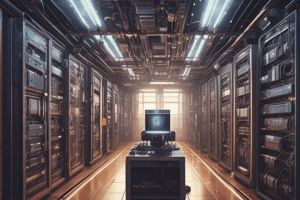Podcast
Questions and Answers
Why is processor speed important for a computer system?
Why is processor speed important for a computer system?
- It measures how much memory can be installed.
- It dictates the quality of graphics on the screen.
- It determines the number of applications that can run simultaneously. (correct)
- It affects the size of the computer's hard drive.
What measurement is used to quantify processor speed?
What measurement is used to quantify processor speed?
- Teraflops
- Megahertz or gigahertz (correct)
- Kilobytes per hour
- Bytes per second
Which factor does NOT impact processor speed?
Which factor does NOT impact processor speed?
- User preferences (correct)
- Manufacturing variables
- Cache size
- Circuit size
What is the primary function of RAM in a computer system?
What is the primary function of RAM in a computer system?
Which type of RAM is commonly used to build cache memory?
Which type of RAM is commonly used to build cache memory?
How do smaller chips affect processor speed?
How do smaller chips affect processor speed?
What term describes applications that require significant data processing capacity?
What term describes applications that require significant data processing capacity?
What distinguishes DRAM from SRAM?
What distinguishes DRAM from SRAM?
What is one of the reasons schools need computers with faster processors?
What is one of the reasons schools need computers with faster processors?
Which storage device deletes data when the power is turned off?
Which storage device deletes data when the power is turned off?
What is a common range of capacity for RAM mentioned?
What is a common range of capacity for RAM mentioned?
Which of the following accurately describes the relationship between processor speed and task completion?
Which of the following accurately describes the relationship between processor speed and task completion?
Which storage device retains its data permanently until it is erased?
Which storage device retains its data permanently until it is erased?
Which scenario would likely NOT benefit from a high processor speed?
Which scenario would likely NOT benefit from a high processor speed?
Which type of memory is generally more expensive but faster?
Which type of memory is generally more expensive but faster?
Which of the following does not function as a primary storage device?
Which of the following does not function as a primary storage device?
What is the primary role of the address bus in a computer system?
What is the primary role of the address bus in a computer system?
What differentiates the data bus from the address bus?
What differentiates the data bus from the address bus?
Which of the following best describes the function of the control bus?
Which of the following best describes the function of the control bus?
What component primarily processes data in a computer system?
What component primarily processes data in a computer system?
What type of memory is specifically identified by the data bus for transmission?
What type of memory is specifically identified by the data bus for transmission?
How does the unidirectional nature of the address bus affect its functionality?
How does the unidirectional nature of the address bus affect its functionality?
In the bus architecture, which component is responsible for user interaction?
In the bus architecture, which component is responsible for user interaction?
Which of the following describes a major characteristic of the address bus?
Which of the following describes a major characteristic of the address bus?
What is the primary reason SSDs are referred to as solid-state drives?
What is the primary reason SSDs are referred to as solid-state drives?
Which storage device is specifically required to use a memory card on a computer?
Which storage device is specifically required to use a memory card on a computer?
Which of the following is NOT true about CDs?
Which of the following is NOT true about CDs?
What distinguishes Optical Storage Devices from other types of storage?
What distinguishes Optical Storage Devices from other types of storage?
What is the typical size range for SD cards?
What is the typical size range for SD cards?
Which storage device is commonly used with car radios and digital cameras?
Which storage device is commonly used with car radios and digital cameras?
What is the maximum storage capacity of a typical CD?
What is the maximum storage capacity of a typical CD?
How many times can data be erased and re-programmed on an EEPROM?
How many times can data be erased and re-programmed on an EEPROM?
What is a key feature of SDRAM that contributes to its performance?
What is a key feature of SDRAM that contributes to its performance?
Which type of ROM can be programmed but not altered after programming?
Which type of ROM can be programmed but not altered after programming?
What is the main advantage of EEPROM over EPROM?
What is the main advantage of EEPROM over EPROM?
Which of the following statements about DRAM is true?
Which of the following statements about DRAM is true?
What is latency in the context of memory processing?
What is latency in the context of memory processing?
Which of the following statements about SSDs is incorrect?
Which of the following statements about SSDs is incorrect?
Which type of RAM includes various generations such as DDR1, DDR2, DDR3, and DDR4?
Which type of RAM includes various generations such as DDR1, DDR2, DDR3, and DDR4?
What operation is performed by ROM when booting a computer?
What operation is performed by ROM when booting a computer?
Flashcards are hidden until you start studying
Study Notes
Basic Computer Architecture
Address Bus and Data Bus
- Computer systems consist of CPU, memory, and I/O devices, communicating via a bus architecture.
- Buses facilitate data transfer: the address bus sends memory addresses (unidirectional), while the data bus transmits data (bidirectional).
- Each I/O device has a unique ID accessed through the address bus.
Virtual Memory and Cache Memory
- Virtual memory allows computers to use hard drive space as additional RAM.
- Cache memory stores frequently accessed data for quick retrieval, enhancing processing efficiency.
Hardware Components
- Motherboard: Main circuit board connecting all components of a computer, allowing communication and power distribution.
- Processor Types:
- CPU (Central Processing Unit): Executes instructions and performs calculations.
- GPU (Graphics Processing Unit): Specialized for rendering images and video.
- Processor Speed: Measured in MHz or GHz; higher speeds allow faster data processing and multitasking capabilities.
- Factors affecting speed include circuit size, die size, and cache size.
Memory Types
- RAM (Random Access Memory): Temporary storage for actively running programs.
- Types of RAM:
- SRAM (Static RAM): Fast and used for cache; retains data as long as power is supplied.
- DRAM (Dynamic RAM): Slower than SRAM, more affordable, used widely for main memory.
- SDRAM (Synchronous Dynamic RAM): Faster than DRAM with pipelining capabilities.
- Types of RAM:
- ROM (Read-Only Memory): Non-volatile memory containing permanent data for booting the computer.
- Types of ROM:
- PROM (Programmable ROM): Can be programmed once; non-volatile.
- EPROM (Erasable Programmable ROM): Can be erased and rewritten using UV light.
- EEPROM (Electrically Erasable Programmable ROM): Can be erased and reprogrammed electrically, allowing more flexibility.
- Types of ROM:
Storage Devices
- Primary Storage: Refers to RAM, necessary for running applications.
- Secondary Storage Categories:
- Magnetic Storage: Hard disks and tapes store data magnetically.
- Flash Memory: USB drives and SSDs use non-volatile memory; SSDs have no moving parts, enhancing speed and reliability.
- Optical Storage: CDs and DVDs store data read by laser:
- CD: Stores up to 700MB; commonly used for audio and data; introduced in 1982.
Software Introduction
- Operating System (OS): Acts as an intermediary between hardware and users, managing resources and facilitating interactions.
- System Software vs. Application Software:
- System Software: Includes OS and utilities for managing hardware.
- Application Software: Programs designed for end-users to perform tasks like word processing or graphics design.
Studying That Suits You
Use AI to generate personalized quizzes and flashcards to suit your learning preferences.



